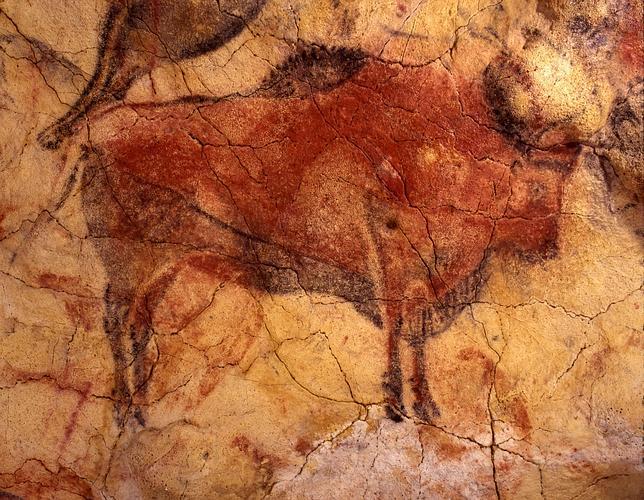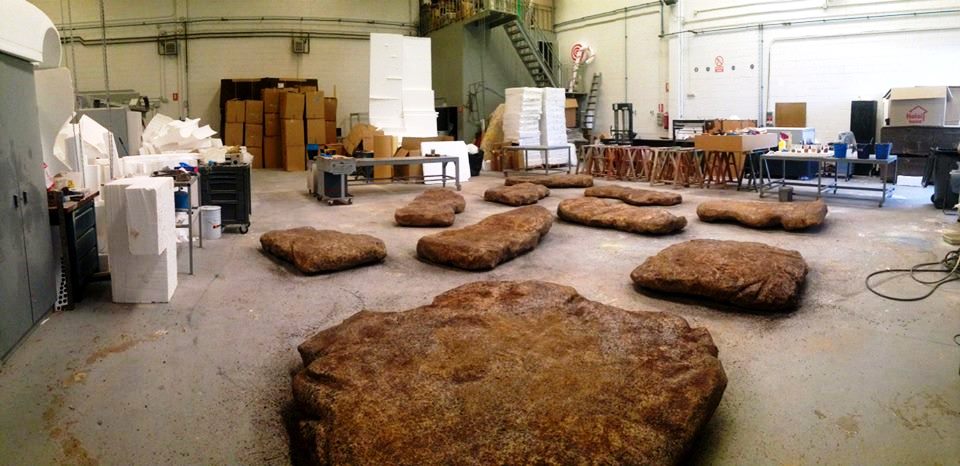
From giant sculptures of Spider Man and Nike shoes for corporate events, to reproductions of historic artworks, artifacts, and archeological sites for museums—including the famous replica of the Cave of Altamira and its Upper Paleolithic drawings and paintings—TroppoVero Studios, outside of Alcalá de Henares, Madrid, “is dedicated to experimental and innovative developments in contemporary sculpture.”
Chloe Boulay ’15, double major in Sculpture and Spanish, discovered an internship opportunity with TroppoVero through the Madrid-based Spanish education company OléSAY and spent a summer interning there as a Scholar Assistant, honing both her artistic techniques and Spanish language skills.
CES: What did your role at TroppoVero Studios entail?
Chloe: I was an assistant to the head artist/studio owner, Sven Nebel. I worked on all of his projects with him, and completed a few entirely on my own. I had pretty much all of the same responsibilities as the employees. It was a small, tight-knit studio, so everyone had a lot of responsibility.
My first project was to create a Dolmen (a type of single-chamber megalithic tomb) for a display at a local children’s museum. It was created out of styrofoam with a fiberglass and sand finish, so that the pieces could be moved easily. I did everything completely on my own; the only guidance I received was when I was learning new techniques that I wasn’t familiar with. Because of this, I had a lot of responsibility in getting started each day and working through issues I came across, and was able to take a lot of creative responsibility for how the final piece looked.

I also did a replica project of a sculpture by the artist Constantine Brancusi; this was more of a learning experience for me to use different sculptural techniques, and I was able to ship it home at the end of my internship.
CES: What did you learn during your time at TroppoVero?
Chloe: The most important thing that I learned was how important was is to be a self starter. Sven later told me that this was the thing that he was most impressed by in having me work for him. Along with that, I learned a variety of sculptural and artistic techniques that I had not previously been familiar with, as well as all of the Spanish vocabulary that is necessary in the art world.
My internship allowed me to see what working in the art world could be like. It was an invaluable experience, and allowed me to improve my existing skill set and gain an entirely new one, as well as setting me up with a great set of references for when my job search begins.
CES: What did you most enjoy about your internship?

Chloe: The most enjoyable part of my internship were the conversations that Sven and I would have throughout the day and during breaks. We also went on a few outings to buy supplies and visit some of his friends’ workshops. We talked about both local and national artists, looked at work that TroppoVero had been commissioned in the past, and discussed how I, as an artist, could hope to be a success in the real world. Getting pointers and hearing stories from someone who had followed their dream of becoming an artist and succeeded in making it their primary job was invaluable to me.
CES: Did any part of your internship cause you to stretch or was any part especially challenging for you?
Chloe: The most challenging part of the internship was breaching the language barrier. While general conversation was easy, learning and using artistic terminology was more difficult.
CES: How has this experience helped with your career goals?
Chloe: My internship allowed me to see how my two majors, Sculpture and Spanish, can be applied to a career in the real world. Along with getting a great letter of recommendation from a pretty well known artist, I now know what it might be like if I were to continue with my art in a realm outside of traditional museum and gallery settings.
CES: What advice would you offer other Puget Sound students considering an internship in the same area of expertise? Or just internships in general?
Chloe: For students trying to do an artistic internship I would say that the most important thing is to make sure you are valued as more than “just an intern.” Be sure that your ideas are, if not used, at least heard.
Sven told me everyday that I was his teacher, not the other way around, and I think that mentality helped me really explore and expand on what I could (and what I thought I could) accomplish. The more confidence that you have in your abilities, the more confidence your supervisor will have in you.
Ready to create your own internship experience? CES can help you sculpt an internship masterpiece!
© 2015 Career and Employment Services, University of Puget Sound
Photos provided by Chloe Boulay and Wikipedia (cave drawing replica)